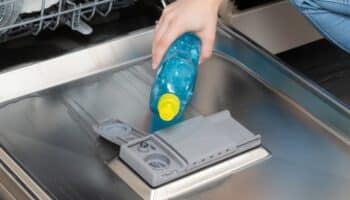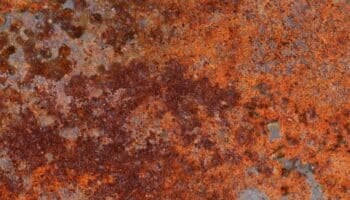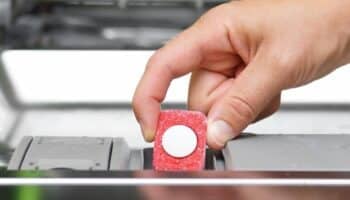We've independently reviewed this article to make sure it's as accurate as we can make it.
To find out more about our article creation and review process, check out our editorial guidelines.
Is your countertop dishwasher not draining water?
You’re not alone! I know how frustrating it can be to open your dishwasher and discover your dishes are still soaking wet.
Luckily, you’ve come to the right place.
If your countertop dishwasher is not draining, make sure the door is closed, clear the kitchen sink, and clean the filter. I also recommend checking the drain hose connection and drain pump.
Keep reading to get rid of the standing water!
Why trust us? This article was written by Craig Anderson and James Blackford.
Craig has helped thousands of other homeowners repair their appliances since 2016. James is one of our resident appliance experts, with over 16 years of experience. He currently works as a Master Technician for SquareTrade, and runs his own appliance repair business.
6 Steps to Fix a Countertop Dishwasher That Won’t Drain
In my experience as an appliance repair expert, I’ve noticed that drainage issues are very common in countertop dishwashers.
Luckily, there are six simple solutions you can try.
#1 Close the Door
If your countertop dishwasher is not draining and has water inside, it’s likely because it didn’t finish its cycle.
Your dishwasher can stop mid-cycle if the door is accidentally opened or if there is a momentary power outage.
In such cases, I recommend closing the door so the wash cycle can resume on its own. But, if there was a power outage, put your dishwasher on a rinse cycle to encourage it to drain the water.
In my experience, countertop dishwashers can also stop mid-cycle and not drain the water if the door latch is faulty. So please check this component and replace it if necessary.
#2 Clear the Kitchen Sink
Your countertop dishwasher can also have drainage issues if your kitchen sink is clogged or blocked.
You see, the drain hose in your tabletop dishwasher is designed to connect to your sink drain. So, by clearing your kitchen sink, you’ll likely get rid of the obstruction that was keeping your countertop dishwasher from draining.
In my experience, one of the easiest ways to clear your kitchen sink is by turning on the garbage disposal.
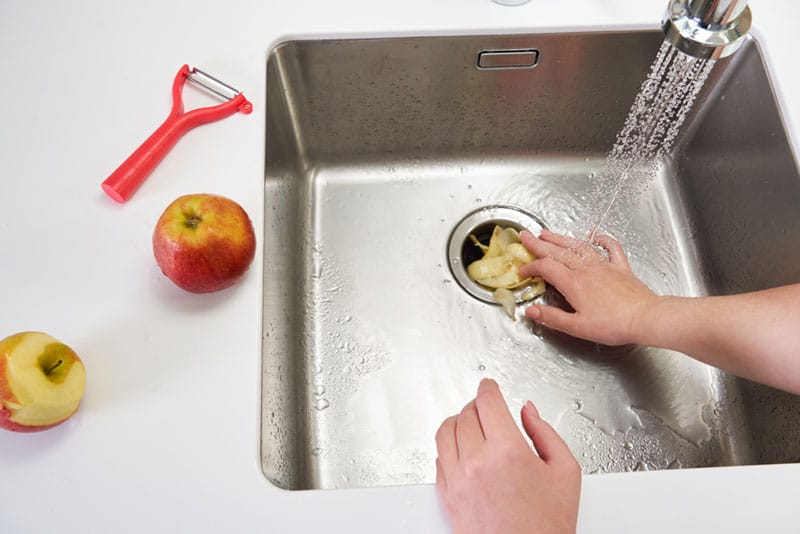
I also recommend pouring half a cup of baking soda followed by half a cup of vinegar down the plughole. Then, let it sit for 20 minutes and run hot water through the plughole to soften food residues and dissolve grease.
You can also use a plunger and a commercial drain cleaner.
NOTE: You should NEVER pour boiling water down the plughole. This could damage your drainage pipes.
Keep in mind that if your kitchen sink gets clogged very often, you likely have an underlying plumbing issue. In such cases, I recommend calling a professional plumber.
#3 Clean the Filter
If the filter is dirty, the water from your countertop dishwasher will not be able to drain properly, which can result in dirty dishes.
You see, when the filter becomes clogged with food particles, it can obstruct the water flow and affect the drain pump’s performance.
To solve your countertop dishwasher draining issues, please remove and clean the filter with hot soapy water. I recommend using a wire or stiff nylon brush to eliminate any stubborn debris.
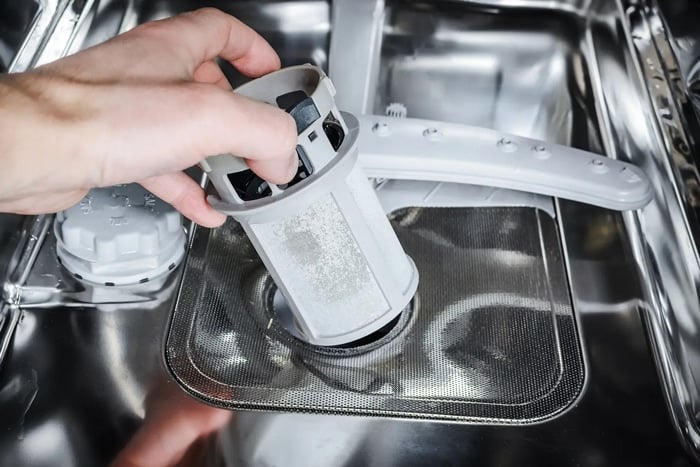
Please check the manufacturer’s manual for detailed instructions on how to remove the filter.
#4 Check the Drain Hose Connection
If your countertop dishwasher is still not draining the water, you’ll need to check the drain hose connection.
Since countertop dishwashers are portable, it can be easy to knock a connection out of place while storing or carrying them.
I recommend ensuring the connections are firmly in place to ensure the drain hose can operate normally and prevent standing water.
Here’s how to check the drain hose connection.
- Turn your countertop dishwasher off and turn it around.
- Check the connection between the drain hose and your worktop dishwasher. If it is loose, use a pair of pliers to tighten it. But be careful not to overtighten the connection.
- Put your dishwasher back in place and turn it on.
#5 Examine the Drain Hose
When a countertop dishwasher is not draining water, I always recommend examining the drain hose to ensure it’s not kinked, clogged, or damaged.
What should you do if your drain hose has any of these problems? Take a look at the following table I’ve prepared:
| Problem | Solution |
|---|---|
| There is a kink in the drain hose. | Remove the kink from the drain hose and straighten it out. |
| The drain hose is squashed. | Remove any obstacles that are putting pressure on it. If the hose is badly damaged, you will have to remove it and replace it. |
| The drain hose is clogged. | I recommend detaching the drain hose and using a snake, old cable line, or wire hanger to remove any blockages. |
Tip: I recommend trying checking the drain hose if you have a portable dishwasher that is not draining.
#6 Check the Drain Pump
If you’ve tried all the fixes above, but your countertop dishwasher is still not draining, you’ll need to check the drain pump.
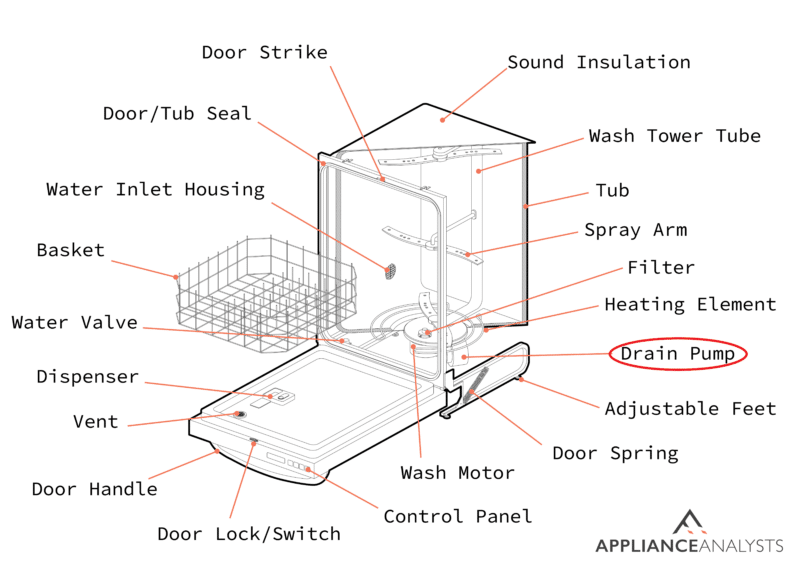
This component pumps the waste water out of the unit. However, sometimes food particles can get stuck in it, affecting its ability to drain water.
Remove any obstructions from the drain pump. In my experience, wearing thick gloves is best, as you may come across pieces of glass or other sharp objects.
If you notice the drain pump is damaged, please replace it with a new one.
If you want to get any replacement part – or see how much one would cost – click to enter your model number in the search bar below. Our partners at AppliancePartsPros stock almost every part with free guides on how to install them.

Persistent Countertop Dishwasher Drainage Issues
If you’ve tried all of the tips in this article but still cannot get your countertop dishwasher to drain water properly, I recommend checking if it is still under warranty. If it is, you’ll be able to get someone to look at it or replace it free of charge.
But, if your tabletop dishwasher is not under warranty, please call a professional. They can help you solve a technical issue with your countertop dishwasher.
Don’t forget to check out our Maintenance & Care Guide to make the most out of your countertop dishwasher and prevent drainage issues.
Conclusion
Hopefully, this article has helped you solve your countertop dishwasher drainage issues.
Remember to close the door, clean the filter, and clear your kitchen sink. Checking the drain hose and drain pump is also crucial to prevent water overflow in your countertop dishwasher.
If this article has been helpful to you, please check out some of our other free guides. You could even sign up to our email list.
Have a great day!
-Craig







